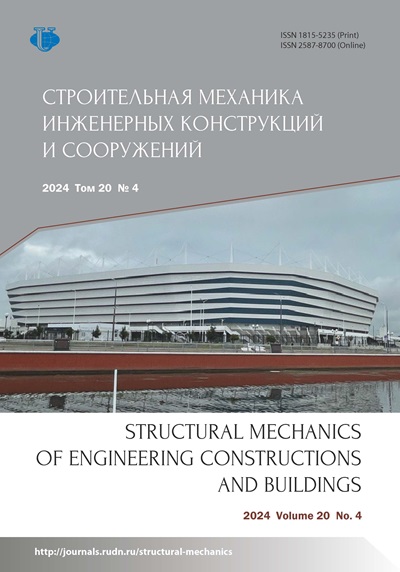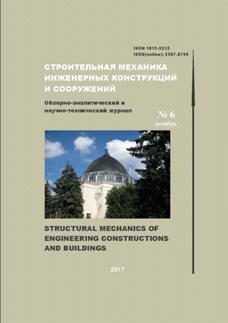No 6 (2017)
- Year: 2017
- Articles: 10
- URL: https://journals.rudn.ru/structural-mechanics/issue/view/1023
- DOI: https://doi.org/10.22363/1815-5235-2017-6
Full Issue
Articles
PARAMETERIZATION OF STRUCTURE ELEMENTS OF COMPLEX GEOMETRY
Abstract
Experimental approach of parametrization of three-dimensional bodies and thin-walled elements of structures of complex geometry is considered Algorithm for constructing a spa- tial network, as well as determining the coordinates, components of the metric tensor and Christoffel symbols are given. Efficiency of modeling elements of complex geometry by a spline version of the finite element method is discussed
 4-9
4-9


CALCULATION OF THE SYSTEM OF TWO CLOSED CYLINDRICAL SHELLS WITH INTERMEDIATE SUPPORT
Abstract
A spatial system of two closed cylindrical shells is considered, having rigid fixation at one end and a free end at the other. Shells are located at some distance from each other and are interconnected by one intermediate link. One of the shells is under the action of a load, concentrated in the annular direction and uniformly distributed along one generatrix. To cal- culate the spatial system, the force method is used. Thus, the calculation of the spatial system is reduced to the calculation of individual closed cylindrical shells. From the condition of equality of radial displacements at the point of contact of the shells, the reactive pressure in the intermediate bond was determined. The magnitude of the reactive pressure in the bond varies depending on the location of the intermediate bond and the geometric parameters of the shells. Knowing the magnitude of the reactive pressure, one can determine the stress-strain state of each shell
 10-15
10-15


ANALYSIS OF THE STRESS STATE OF THREE-LAYERED ANISOTROPIC FOUNDATION
Abstract
The results of calculations based on the equations of the plane problem of the theory of elasticity for determining stresses in a three-layer anisotropic base under the action of a static normal surface load are presented. It is considered a variant of the complete cohesion between the layers. The stress functions in each layer are written through the normal and tangential forces arising on the line of contact between the strip and the half-plane. The contact forces between the strip and the half-plane are determined from the system of two equations and conditions on the surface of the base. As a result, the stress functions in each layer are written through the surface load in the form of improper integrals. An analysis of the stress state is carried out according to the model of a three-layer iso- tropic base, depending on the elastic characteristics of the material of the layers. The influence of anisotropy of the material of layers in a three-layer soil mass is shown.
 16-24
16-24


ERRORS OF INTERNATIONAL STANDARDS ON REINFORCED CONCRETE AND RULES OF THE EUROCODE
Abstract
The proposed work identified and analyzed the errors in the theory of viscoelasticity of concrete in international norms for concrete and reinforced concrete, new equations of the theory of creep of concrete, taking into account the instant nonlinearity, nonlinear creep and inertial properties of concrete. The results of the study are brought to the charts and tables, convenient for use by ordinary designers. The article was written in accordance with the recommendations of the round table, held at RUDN University on June 9, 2016 under the guid- ance of Doctor of Technical Sciences, prof. S.N. Krivoshapko.
 25-36
25-36


EXPERIMENTAL STUDIES OF DEFORMATION OF REINFORCED CONCRETE STRUCTURES SUBJECTED TORSION AND BENDING
Abstract
The results of experimental studies of reinforced concrete constructions at complex resistance to torsion with bending are shown in the article. The main purposes of the researches are detection of regularities and determination of deformation and cracking parameters. The most important of the studding parameters are cracking load, destructive load, the coordinates of spatial cracks formation, the width of crack's opening at the axis of the longitudinal and transverse tensile reinforcement and along the entire profile of cracks; changing the distance be- tween the cracks and crack length according to increasing the deformation load; deformation of compressed concrete and reinforcement in a complex stress-strain state. The test results are presented in the form of relationships of structure's deflections, deformations of compressed concrete and reinforcement, including results which were determined by the indications of electrotensometric sockets. The obtained relationships allow us to assess the reliability of the calculating methods reinforced concrete constructions subjected the action torsion and bend- ing.
 37-44
37-44


SUSTAINED FORCE DEFORMING OF STRUCTURED MATERIALS
Abstract
The Scientific-and-Research Institute of Building Physics (NIISF), Moscow, Russia **TzNIISK named after V.A. Kucherenko (AO “NITz “Stroitel’stvo””), Moscow, Russia Relationship between value of loading and mechanical characteristics of structured materials is explored. A uniform analytical description of creep for stages of stable deformation, damped at time, stable and unstable critical deforming are introduced into practice for the first time
 45-48
45-48


NUMERICAL SIMULATION OF TRANSIENT STRESS WAVES IN ELASTIC HALF PLANE WITH A RECTANGULAR CAVITY WHILE CENTERING THE VERTICAL EXPLOSIVE IMPACT
Abstract
The paper provides some information modeling safety elastic half plane in the case of non-stationary wave explosive impact using the finite element method. Considered the wave theory of explosive safety. Applicable technical tool in the form of vertical rectangular cavities to increase the security of the object when focused vertical explosive impact. The explicit two-layer scheme. Reviewed the problem statement with the cavity (ratio of width to height of one to four) in a half-plane when exposed in the form of Delta functions. Solve the system of equations of 59048 unknown. Explosive impact is modeled as a triangular pulse. Five points is a change in the grid voltages.
 49-54
49-54


PARAMETERS OF ROCK STRUCTURES FOR UNDERGROUND ORE MINING
Abstract
The concept of preservation of the earth's surface from destruction is realized in the present work through regulating the stresses by coordinating the processes of excavating the ore in time and space according to the criterion of stress minimization. Justification of technological solutions that ensure the preservation of the massif and the earth's surface above it due to the phenomenon of residual strength of disturbed rocks is the purpose of the article. The goal is achieved through analysis of mining practices, established behavior patterns of massifs with a discrete gravity-tectonic structural stress field and methods to ensure their stability by creating conditions for locking rocks within the dome of natural equilibrium. It is shown that the geomechanical balance of discrete rock structure is provided due to the residual bearing capacity of naturally and technologically depleted rocks. A solution is proposed for the prevention of critical stresses and their corresponding deformations by dividing the mine field into areas with a flat roofing, within which cost-minimized technologies can be applied. It is recommended to supplement the criterion of repayment optimality with the amount of compensation for damage to the environment. The typification of the mines depending on stability and disturbance of massifs is given. The condition of the solidity of the massif at various stages of existence is formulated - the condition of the geomechanical balance of the geomechanical system. The workings can be typified according to the stability, depending on the size of the structural blocks of rocks in the roof. The new classification of backfilling technologies with taking into account the phenomenon of rock blocks locking is proposed. Due to the residual bearing capacity of naturally and technologically depleted rocks, under underground mining of deposits there are rock constructions whose properties are corrected by dividing the mine field into geomechanically balanced sections with flat roofing
 55-67
55-67


THE STABILITY OF PLATES UNDER THE ACTION OF SHEARING LOADS
Abstract
The method of stability analysis of plates under the action of shearing loads is presented. Using variation method of Vlasov, the set of differential equations of stability of plates is giv- en. As an example, the stability calculation of rectangular plate hinge-supported along four sides under the action of shearing load in a median surface is realized. The numerical algorism of stability analysis of plates by the method of continuation on parameter of shearing load is developed, the Fortran program is realized. The obtained value of critical load is leveled with the table data
 68-73
68-73


BORASSUS AETHIOPUM MART OF BENIN USED AS REINFORCEMENT IN CONCRETE: ADHESION CARACTERISATION
Abstract
Researches carried out in Benin allowed the use of Borassus aethiopum mart as reinforcement in concrete. The aim of this study is to examine the bond of the two materials. The results of pull out tests have shown that the bonding strength is around 1 MPa. This adhesion rate decreases slightly when the bond length increases; on the other hand, the adhesion rate increases slightly when the concrete strength increases. The behaviour of Borassus / concrete interface shows a first phase of perfect adhesion followed by a second phase of progressive loss of adhesion and a final friction phase which continues until the complete output of the reinforcement from the concrete.
 74-80
74-80
















